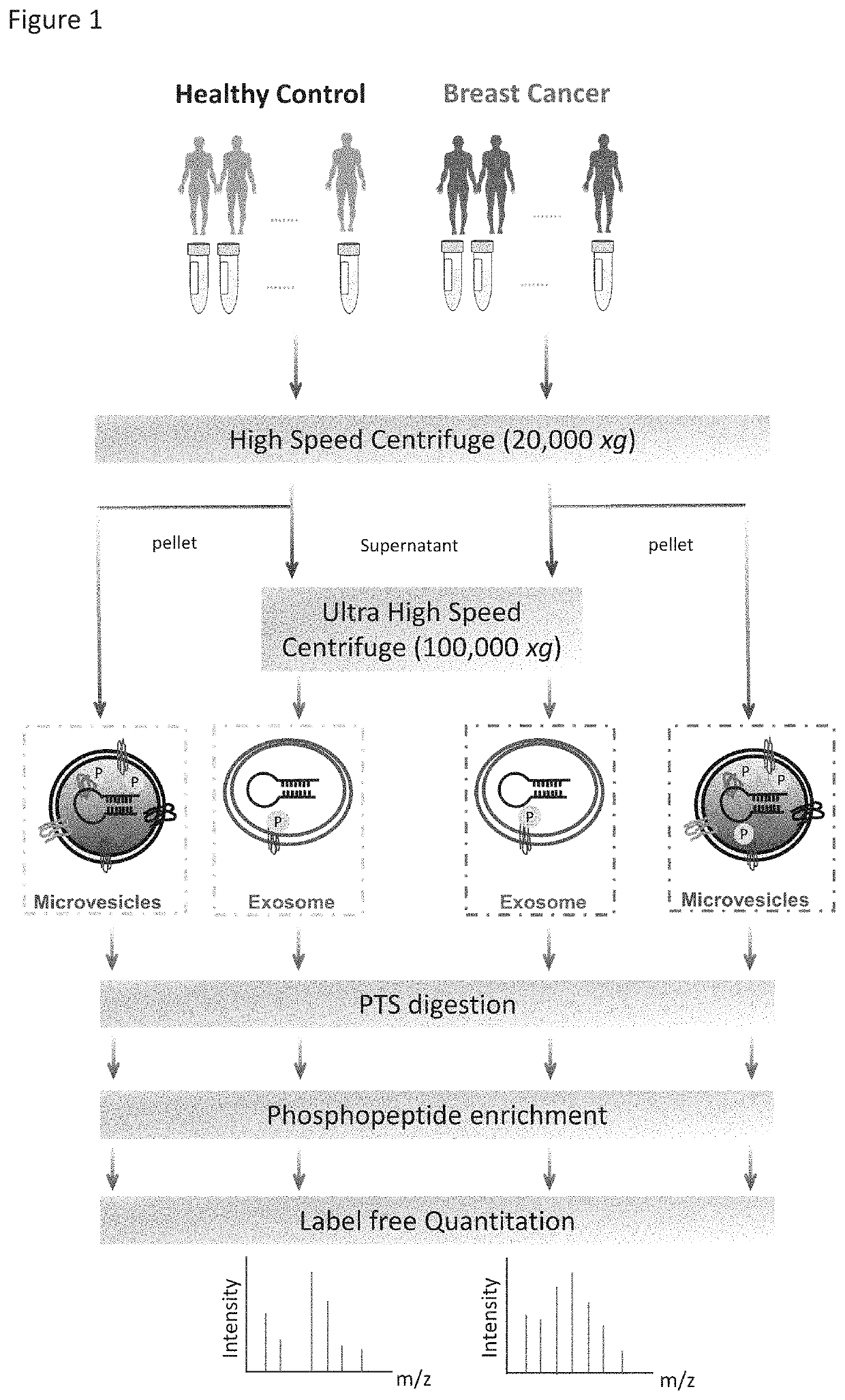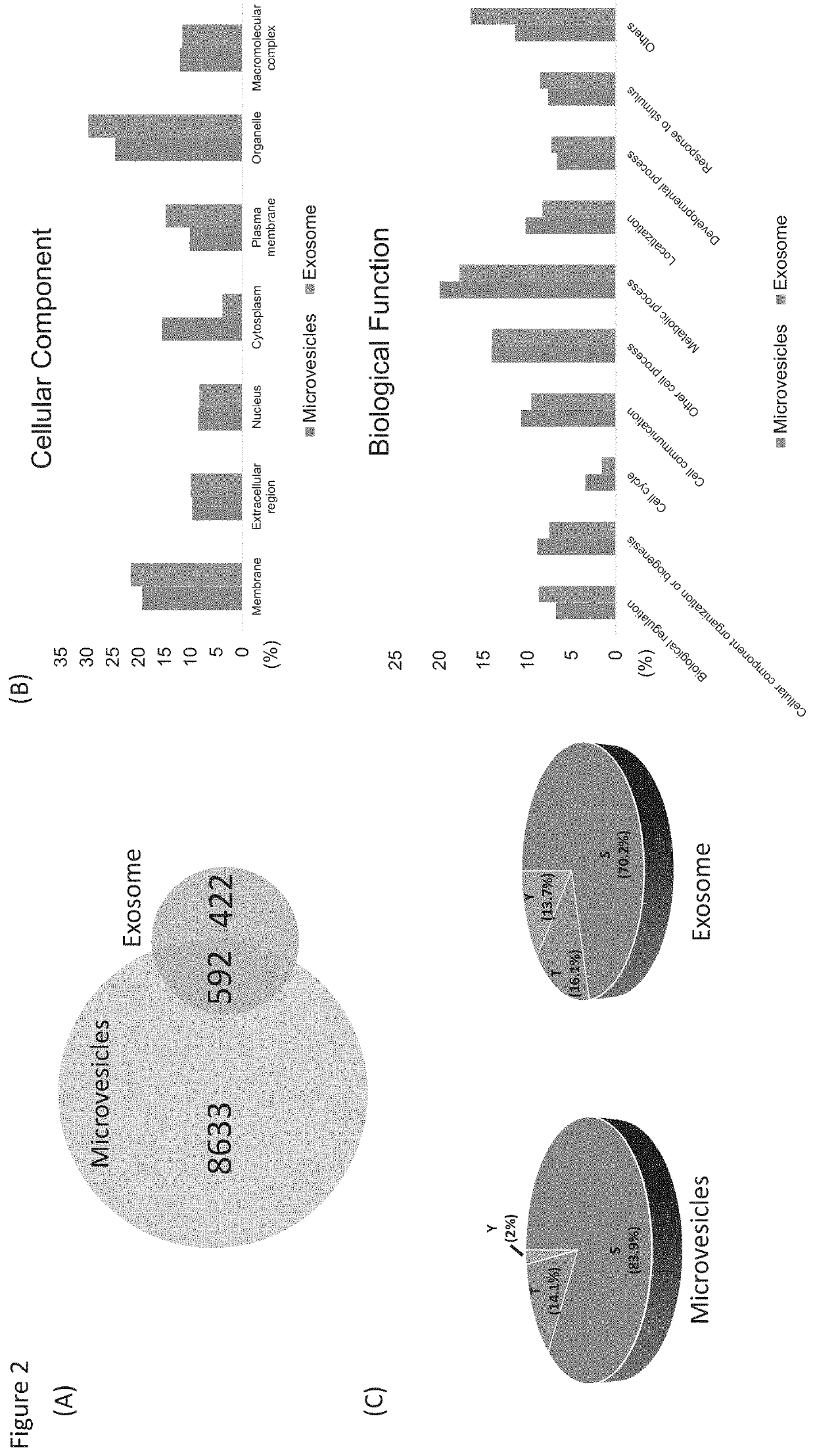Phosphoproteins in extracellular vesicles as candidate markers for breast cancer
a technology of phosphoproteins and vesicles, applied in the field of breast cancer candidate markers, can solve the problems of inability to keep the neural cytoskeletal structure organized, and no systematic method to decipher the correlation between phosphoproteins/glycoproteins and various cancer diseases
- Summary
- Abstract
- Description
- Claims
- Application Information
AI Technical Summary
Benefits of technology
Problems solved by technology
Method used
Image
Examples
example 1
Identification of 9,643 Unique Phosphopeptides From Plasma Microvesicles and Exosomes
[0068]In this Example, we illustrated the preliminary screening of phosphopeptides from plasma microvesicles and exosomes.
[0069]The workflow for the isolation of EVs, enrichment of phosphopeptides, and EV phosphoproteome analyses is illustrated in FIG. 1. Microvesicles and exosomes were isolated from human plasma samples through high-speed and ultra-high-speed centrifugations, respectively, an approach that has been employed in multiple studies and can effectively isolate EVs in good purity. For initial screening, the plasma samples were collected and pooled from healthy individuals (n=6) and from patients diagnosed with breast cancer (n=18). After lysis of EVs, proteins were extracted and peptides were generated using trypsin with the aid of phase-transfer surfactants (PTS) for better digestion efficiency and fewer missed tryptic sites. Phosphopeptides were enriched and followed by LC-MS / MS analyse...
example 2
Cancer Specific Phosphoproteins in EV
[0072]In this Example, we establish that looking the differences of EV phosphoprotein level from patient sample and healthy donor sample may identify a panel of phosphoproteins as the biomarker for diagnosing the disease at issue.
[0073]Label-free quantitation of phosphopeptides with probability score of phosphorylation site location over 0.75 was used to identify differential phosphorylation events in breast cancer patients from healthy individuals. We quantified 3,607 and 461 unique phosphopeptides and identified 156 and 271 phosphopeptides with significant changes (FDR<0.05 and S0=0.2) in microvesicles and exosomes, respectively (FIGS. 3A&B). Differential phosphorylation may be a result of changes in protein expression or changes in a particular site's phosphorylation. To distinguish these factors, we also performed the label-free quantitation of total proteomes for both microvesicles and exosomes (FIG. 3C). Altogether, we identified 1,996 prot...
example 3
Verification of Cancer Patient-Specific Phosphorylation Using PRM
[0076]In this Example we further validated the phosphoprotein biomarker candidate identified in Example 2.
[0077]Since breast cancer is extremely heterogeneous, the chance to identify a single diagnostic biomarker is likely rare. Instead, the identification of a panel of candidate markers that reflect the onset and progression of key disease-related signaling events would be feasible to offer better prognostic value. In effort to validate the differential phosphorylation of potential markers in cancer patients, we applied Parallel Reaction Monitoring (PRM) to quantify individual EV phosphopeptides in plasma from breast cancer patients and healthy individuals. Since phospho-specific antibodies suitable for construction of enzyme-linked immunosorbent assay (ELISA) are rarely available, targeted, quantitative MS approaches such as PRM and MRM (multi-reaction monitoring) are essential for initial validation. As a demonstrat...
PUM
| Property | Measurement | Unit |
|---|---|---|
| diameter | aaaaa | aaaaa |
| diameter | aaaaa | aaaaa |
| time | aaaaa | aaaaa |
Abstract
Description
Claims
Application Information
 Login to View More
Login to View More - R&D
- Intellectual Property
- Life Sciences
- Materials
- Tech Scout
- Unparalleled Data Quality
- Higher Quality Content
- 60% Fewer Hallucinations
Browse by: Latest US Patents, China's latest patents, Technical Efficacy Thesaurus, Application Domain, Technology Topic, Popular Technical Reports.
© 2025 PatSnap. All rights reserved.Legal|Privacy policy|Modern Slavery Act Transparency Statement|Sitemap|About US| Contact US: help@patsnap.com



